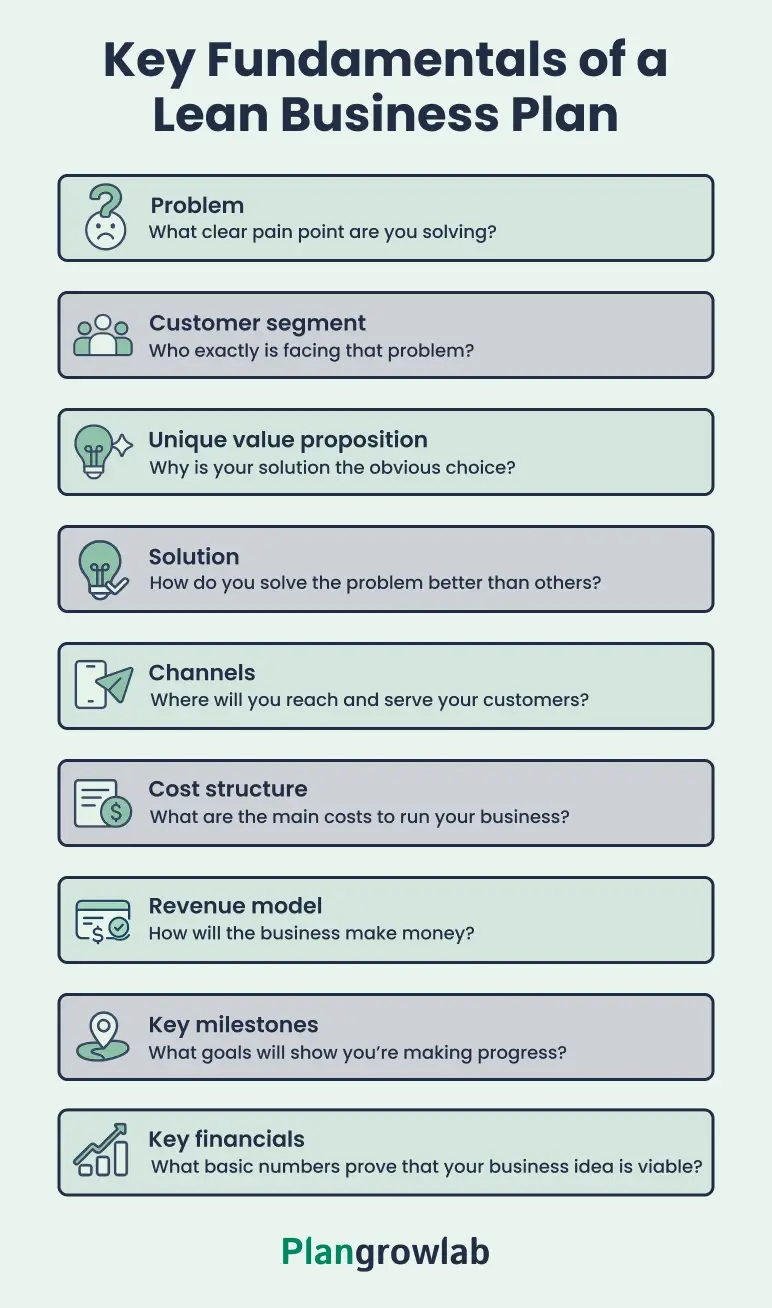Nearly 70% of businesses in the U.S. now have a written business plan that documents strategy, outlines key milestones, and has a useful roadmap to achieve them. Five years ago, that number was just 35%.
What brought this change?
I would say a couple of things. Entrepreneurs now have more access to planning tools, there is a shift toward smarter goal setting, and a clear understanding that a business plan isn’t just for banks.
But above all, it’s the rise of lean planning that makes building a business plan seem doable, even for solo founders and first-time planners 😍.
Lean plans give founders a simple starting point, and in many of the projects we support, that quick start turns into something more detailed as the business grows.
A lean business plan developed from the lean planning approach is clearer, useful, and faster to develop. But are these plans the same as traditional plans?
And above all, can you transition from a lean to a traditional plan when needed?
Let’s get all the answers in this read.
What is a lean business plan?
A lean business plan is a high-level overview of your business fundamentals without diving in depth. Think of concisely highlighting your business idea, target market, strategy, and basic financials in a page or two without unnecessary elaboration.
A lean business plan is ideal when you’re still refining your business idea or need a roadmap for yourself rather than for investors. It’s quick to build and effectively instills the clarity necessary to scale your business.
How is a lean business plan different from a traditional plan?
A lean plan isn’t just a shorter version of your traditional plan. It’s a draft-style quick plan that serves a different purpose and is better suited for specific situations.
Here’s how a lean business plan is different from a traditional plan:
| Point of difference | Lean plan | Traditional plan |
|---|---|---|
| Purpose | To guide internal planning and management decisions | To support growth and secure funding |
| Length and detail | High-level overview of business fundamentals captured in 1–2 pages | Detailed elaboration of strategies and financials captured in 20–40 pages or more |
| Time to draft | Can be built in as little as 15 minutes | It can take anywhere from an hour to a couple of days to place a traditional plan together |
| Flexibility and adaptability | Easy to adapt as the business evolves | It's quite rigid and set in stone |
| Business stage | More suited for idea validation and clarity in early stages | More suited when the business is scaling its operations or attracting stakeholders |
| Planning approach | Prioritizes speed, learning, and iteration | Prioritizes structure, accuracy, and polish |
Why start with the lean business plan?
Lean plans offer a perfect starting point for businesses building their products/ services in a rapidly changing marketplace. Oftentimes, we recommend lean plans during early-stage consulting sessions, especially when founders are validating ideas or building in uncertain markets.
Starting with such a plan is much more practical than starting with a traditional plan because:
- Faster and easier to create: With a lean plan, you won’t be spending time elaborating or digging depth. This way, you would have a practical, easy-to-use plan ready in minutes
- Flexible and easy to update: In business, you need a living document that makes adjustments and reviews easier, exactly what the lean methodology focuses on
- Focuses on what matters most: Lean plan focuses only on aspects that matter the most, i.e., value proposition, target customers, revenue model, so that you can have a laser-sharp vision rooted in reality
- Encourages action and iteration: Lean plan enables you to iterate, refine, and tweak the strategies rapidly, so that you can start executing sooner and improve your strategy on the go
- Less intimidating for everyday use: A lean plan acts as a one-page strategic cheat sheet aiding day-to-day decision making. This way, your plan can actually be put to use
We work with founders who begin with a lean plan to get clarity and move fast, and later come back to us when they need help turning that plan into a detailed strategy for growth or funding.
That said, a lean plan offers a starting point that makes in-depth planning easier later on when you want to add more nuance and depth to your strategies.
Key components of a lean business plan

You don’t need a defined structure or guidelines while writing a lean business plan. But try and include details about the following components to build a highly contextual plan with sufficient insights:
1) Problem
Every successful business solves a problem or satisfies a need. Describe that gap in the market very briefly, in a line or two.
For instance, a problem statement for a healthy meal prepping company could be:
“Lack of affordable healthy meal options for busy parents and working professionals”
This section sets the stage for why your business should exist, so explain it very clearly. No fluff, no jargon.
2) Customer segment
Focus on who has the problem you’re solving and is most likely to pay for your solution. That’s your target market.
Now, you can have multiple customer segments interested in your business. The idea is to define them by their geography, age, behavior, need, or income to instill more clarity.
For instance, your healthy meal prepping company (in the San Francisco Bay Area) can have different customer segments like:
- Urban working professionals in the age group of 25-40
- Small families looking for affordable meal options
- Fitness enthusiasts looking for quick, on-the-go meals
Build a clear customer list so that you can develop targeted marketing materials for each segment.
3) Unique value proposition
Establish your clear competitive edge and spell out exactly what sets your business apart.
What does your business offer that:
- A competitor isn’t offering
- Better than the competitor
- Solving a gap in the market
Is it a cheaper product? Is it a niche that competitors aren’t targeting? Is it a cost advantage?
For instance, nutritious and healthy vegan meals at affordable rates.
4) Solution
Explain your solution to the problem, i.e., product or service offering. As you describe the solution briefly, focus on the benefit to the customer.
For example, “We deliver pre-portioned healthy dinner kits to families' doorsteps.”
Essentially, this is where you highlight your value proposition. That is what makes your solution effective and maybe unique.
5) Channels
Summarize how you’ll reach your customers and promote your business.
Now, you don’t need a full marketing plan. Just highlight the key marketing and sales channels you’ll use.
For instance, we will take food orders through third-party apps and our own application. We will use social media, influencer marketing, and local SEO to promote our business initially.
6) Cost structure
List the major costs required to run your business, i.e., recurring and fixed expenses that keep the operation going. This includes costs for product development, marketing, salaries, software tools, logistics, and supplier costs.
You don’t need a detailed cost structure here. Just list down the key cost categories for your business.
For instance, Every month, we would be incurring $50,000 fixed expenses on rent, inventory, payroll, packaging, and delivery platform fees. In addition, we would be spending $2,000 on marketing every month.
The goal of this section is to understand where your money goes and what your biggest cost drivers are.
7) Revenue model
Outline how your business will make money.
List down your main revenue streams and outline how often the customer would be paying you.
For instance, monthly meal subscription plans, one-time meal kit pricing, tiered pricing, and project-wise branded collaborations.
Keep this section clear and ensure it’s clear where the revenue comes from. If you have multiple streams, list the primary ones.
8) Key metrics and milestones
List a few major milestones such as launch dates, product prototypes, opening a location, reaching a sales target, or obtaining a certain number of customers, along with a rough timeline. Having this clarity will turn your plan into an actionable roadmap.
For instance, launch a meal delivery service in the San Francisco Bay region by Q3 2025
Milestones show that you’ve thought about what needs to happen and when, and they help you track progress as you go.
9) Key financials
You don’t need detailed spreadsheets here, but do include essential financial projections or targets. This could be your expected revenue or sales for the first year, main cost estimates, and when you anticipate breaking even or becoming profitable.
You might also include key figures like startup costs needed, monthly expenses, and desired profit margins.
For instance, we aim to deliver 60,000 orders within 12 months of our launch and a revenue of $800,000 by then. Every month, we would be spending nearly $40,000 on our fixed and recurring expenses, and by Q2, we would break even.
Remember, the lean plan keeps it brief. You can always attach a simple table or do more detailed forecasts separately, but in the lean plan, just summarize the bottom-line outlook.
From our experience, even basic numbers give early businesses a clearer direction. If you're unsure how to forecast, use simple logic tied to unit sales or usage patterns. We often help clients structure these estimates in a way that sets up future financial modeling without getting stuck in spreadsheets too early.
That’s pretty much all the details you should be including in a lean plan, in small and separated sections.
How to create a lean business plan (using lean canvas)
Let’s now quickly walk you through a couple of systematic ways to create your lean business plan.
- Start with PlanGrowLab’s lean canvas template with prompts and examples to help you get a head start. It's built with prompts and examples based on what actually works in planning sessions with our clients.
- Gather your team and start filling in each space to place together a clearly defined canvas.
- You can use AI to fill in the template and put together a simple, jargon-free draft
- Clearly define the problem and the solution you have to offer. Clarify your target audience and list down your direct and indirect competitors.
- Think of suitable marketing channels for your business and establish clear, measurable goals
- Fill in essential financial metrics like expected revenue, total startup costs, break-even point, and capital required
That said, you can write paragraphs in your lean plan, but bullets are much more efficient and easier to follow.
Also, remember this is just a plan for idea validation and clarity. It’s not sufficient to secure funding or grow your business. A lean plan will help you build a detailed plan necessary for direction.
Free lean business plan template (download)
Starting to write your lean business plan but need a bit of guidance? We’ve got you covered! Download our lean business plan PDF to kickstart your journey.
This one-page template is perfectly crafted to help you build highly efficient lean business plans. Each section is followed by a practical prompt that ensures that you include all the details essential to build a high-level overview.
Next: Transition from lean to traditional business plan
The best thing about a lean plan?
You can build on its fundamental blocks and transition it into a detailed plan as the business grows.
But here’s the thing: growing your plan means going deeper.
This includes developing detailed financial projections, figuring out your target market with extreme specificity, analyzing your competitors and building your competitive edge, clearly laying out your operations, and defining your business strategies.
It’s not that simple. And it’s definitely more than a simple writing job.
At this stage, the guidance of experienced business plan consultants at PlanGrowLab can make a real difference. They help you bring clarity to complex decisions and craft a plan that works as a roadmap for growth.
When founders reach this stage, we help them make sense of all the moving parts—from market validation to solid financials. A detailed plan needs more than just writing; it needs thinking, sequencing, and clarity. That’s where working with a business planning expert can save time and avoid rework later.
Instead of feeling overwhelmed by all the moving parts, you gain a clear direction and the confidence to move forward.
Frequently Asked Questions
Is a lean business plan suitable for investors?
While a lean plan can help you secure a meeting with investors, they need supporting financials, market research data, an operational plan, and product MVPs (all part of a detailed plan) to make a decision.
Can I use a lean business plan for a bank loan?
No, banks require a detailed business plan outlining everything from market research to financial projections in a required format. Ideally, you should follow SBA’s business plan guidelines/ format to build a bank-worthy business plan.
How often should I update my lean business plan?
A lean plan should be updated every month to keep it relevant. Since these plans are quick to edit, you can revise them easily when you learn something new about your market or customers.
Can I create a lean plan in Google Docs or Excel?
You can absolutely develop your lean plan in Google Docs and Excel. However, instead of creating a plan from scratch, use a lean plan template to quickly fill in the blanks.
What’s the difference between a lean plan and a business model canvas?
A lean plan is a short business plan with clear actions, timelines, and financials. A business model canvas, on the other hand, is a visual tool that maps out how your business creates and delivers value. While the former helps you operate, the latter helps you think through the model.

